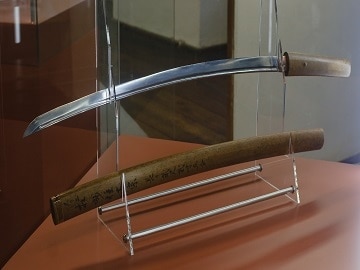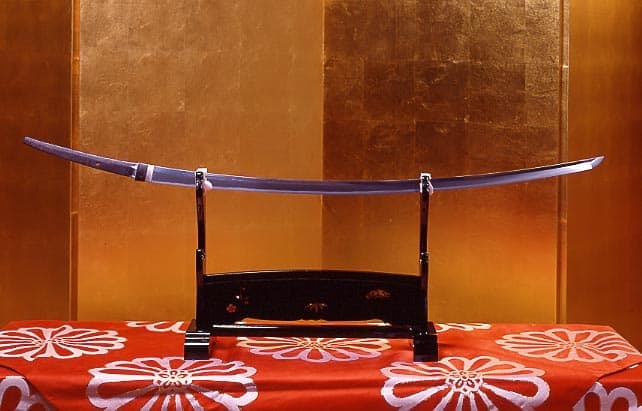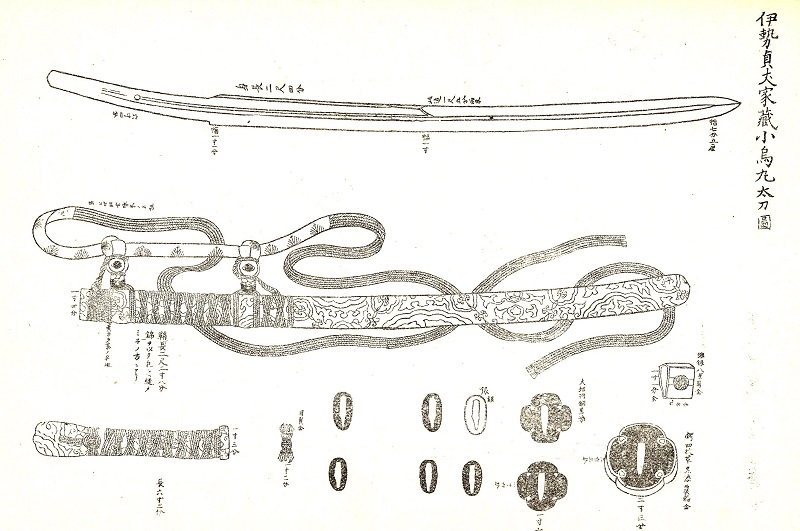what is the heaviest sword known to have been used
Japan has a long history of making samurai swords. The earliest swords looked nothing like the well-known katana, and were straight double-edged blades based on the Chinese Jian. Still, the Japanese did not feel that this blazon of sword was expert plenty for gainsay and eventually, the first truthful samurai sword, the tachi, was created by a man named Amakuni. Tachi await similar to katana, but are not as curved. Since these samurai swords were skillfully crafted and handed downwardly from i generation to the next, many early samurai swords notwithstanding exist. This list covers some of the oldest and most of import samurai swords in Japan's history.
vii. Honjo Masamune
Year Created: c. late 13th to early on 14th century
Swordsmith: Masamune
Sword Blazon: Tachi
Present Location: Unknown – lost since the end of Globe War Two
 photo source: Wikimedia Commons (a different Masamune sword is pictured because no public pictures of the Honjo Masamune exist)
photo source: Wikimedia Commons (a different Masamune sword is pictured because no public pictures of the Honjo Masamune exist)
Masamune is known for existence Japan's greatest swordsmith ever. While Masamune created numerous swords, the Honjo Masamune is considered his best work. The Honjo Masamune is also ane of Japan'southward greatest treasures and is so important to the state considering the sword was a symbol of the Tokugawa shogunate during almost all of the Edo period (one of Japan's longest and greatest periods of prosperity). After the Honjo Masamune was acquired by Tokugawa Ieyasu, the sword was passed down from shogun to shogun.
Although the Honjo Masamune is of not bad importance to Japan, the sword has been missing since the finish of World War II. Event afterward the fall of the Tokugawa shogunate, the Honjo Masamune stayed with the Tokugawa family and during the War it was owned by Tokugawa Iemasa. Unfortunately, after Japan surrendered, the Allied Forces demanded the noble families to turn over their swords. Instead of resisting like the other nobles, Iemasa willingly handed over 14 of the Tokugawa's swords, including the Honjo Masamune. To this twenty-four hours, no one knows where the Honjo Masamune is (it may be in America), but Japan is still hoping that the sword will plow upwardly.
vi. Onimaru Kunitsuna
Year Created: c.13th century
Swordsmith: Awataguchi Sakon-no-Shōgen Kunitsuna
Sword Type: Tachi
Present Location: Imperial Household Agency
 photograph source: Japanese Sword Legends
photograph source: Japanese Sword Legends
The Onimaru Kunitsuna of the "Demon Sword" is ane of the Tenka-Goken or Japan'southward legendary "Five Swords Nether Sky." As the name implies, this particular samurai sword was used, co-ordinate to legend, to impale a demon or an oni. Hōjō Tokiyori, the regent of Kamakura, vicious sick and was existence haunted by a pocket-sized demon. Tokiyori dreamt of an former man who told him that he was his sword fabricated by Kunitsuna and that he could go rid of the demon once it was cleaned.
Afterwards Tokiyori cleansed the sword, it magically cruel out of its rack and sliced off the pes of the nearby brazier. The foot was shaped like a demon and Tokiyori was never haunted once more. The Onimaru Kunitsuna became a prized treasure of the Hōjō family and concluded upwards with the Ashikaga family, who as well valued the sword.
five. Juzumaru-Tsunetsugu
Yr Created: c. early13th century
Swordsmith: Aoe Tsunetsugu
Sword Type: Tachi
Present Location: Honkōji Temple in Amagasaki
 photo source: japansauce.net
photo source: japansauce.net
The Juzumaru-Tsunetsugu is known as the rosary (juzumaru) sword because of its association with the Buddhist reformer Nichiren. The sword was given to Nichiren by his most important patron Nanbu Sanenaga, who wanted Nichiren to utilize the sword for protection. Nichiren was not interested in actualy using the sword and saw it equally a symbol for the "destroying of inquinity and establishing righteousness" and placed a Buddhist rosary on its hilt, thus giving the sword its proper name Juzumaru-Tsunetsugu.
Aoe Tsunetsugu, who was a swordsmith during the early 13th century, is oftentimes credited with creating the Juzumaru-Tsunetsugu. Yet, the Juzumaru shows some differences in its workmanship compared to other Aoe Tsunetsugu swords. Also, the signature on the Juzumaru is on the other side of where Aoe would have typically singed his swords. The Juzumaru-Tsunetsugu may have actually been made past the Tsunetsugu at the Ko-Bizen smith and date back to the tardily 12thursday century.
4. Ōtenta-Mitsuyo
Year Created: c.11th century
Swordsmith: Miike Tenta Mitsuyo
Sword Type: Tachi
Present Location: Maeda Ikutokukai in Meguro, Tokyo
 photo source: Japanese Sword Legends
photo source: Japanese Sword Legends
The Ōtenta-Mitsuyo is often associated with the Maeda family even though the sword has had several different owners. The Maeda family named the Ōtenta-Mitsuyo after Miike Mitsuyo, or the "Great Tenta", who is credited every bit the sword'south smith. Originally, the Ōtenta-Mitsuyo belonged to the Ashikaga family and was passed downward from shogun to shogun. The Ōtenta-Mitsuyo, another Tenka-Goken sword, the Onimaru-Kunitsuna, and the now lost Futatsumei-Norimune were the three treasure swords of Ashikaga Takauji.
Eventually, the three swords were passed down to Toyotomi Hideyoshi for unifying Japan. According to fable the Ōtenta-Mitsuyo concluded upward with the Maeda family unit when Hideyoshi offered it to Maeda Toshiie to fight the evil forces that made his daughter Gō. Since then, the Ōtenta-Mitsuyo has been closely guarded past the Maeda family unit.
3. Mikazuki Munechika
Year Created: c.10th – twelfth centuries
Swordsmith: Sanjô Munechika
Sword Blazon: Tachi
Present Location: Tokyo National Museum
 photo source: Japanese Sword Legends
photo source: Japanese Sword Legends
The Mikazuki Munechika is some other ane of Japan'due south Tenka-Goken and is considered the most cute of the five blades. This tachi style samura sword was created Sanjô Munechika and was named for its crescent moon shape (mikazuki). Like all of the Tenka-Goken, the Mikazuki Munechika is one of Japan'south National Treasures and is currently on display at the Tokyo National Museum.
Over its long history, the Mikazauki Munechika has been owned by several important Japanese families. During the mid-sixteenthursday century, the Mikazuki Munechika belonged to the Ashikaga family and the sword was used by shogun Ashikaga Yoshiteru to defend himself until he died during an attack on the palace by the Miyoshi family. The sword, along with other Ashikaga treasures, was taken by Miyohsi Masayasu. The Mikazuki Munechika was passed down a few more times before it was owned past the Tokugawa family.
two. Dōjigiri Yasutsuna
Twelvemonth Created: c.10th – 11th centuries
Swordsmith: Hōki-no-Kuni Yasutsuna
Sword Blazon: Tachi
Present Location: Tokyo National Museum
 photo source: Japanese Sword Legends
photo source: Japanese Sword Legends
The Dōjigiri Yasutsuna is the oldest of the Tenka-Goken. The Dōjigiri was created past Yasutsuna of Hōki, who built upon the piece of work of his predecessor Amakuni, who forged the first true samurai sword. Co-ordinate to historians, the craftsmanship of the Dōjigiri is so impeccable that information technology inspired legendary swordsmith Masamune.
Like many of Nippon's greatest samurai swords, the Dōjigiri was used in a legendary boxing. The Dōjigiri Yasutsuna got its name after Minamoto no Yorimitsu used the sword to kill the theiving demon, Shutendōji. The Dōjigiri became ane of Nihon's most cherished treasures and was used by shoguns Toyotomi Hideyoshi and Tokugawa Ieyasu. Today, the Dōjigiri is displayed at the Tokyo National Museum.
1. Kogarasu Maru
Year Created: c.eighth century
Swordsmith: Amakuni
Sword Blazon: Tachi
Present Location: Japanese Imperial Drove
 photo source: Wikimedia Commons
photo source: Wikimedia Commons
While the Kogarasu Maru may not accept been the first sword created by Amakuni in the viiithursday century, information technology is the most famous i that still exists. Amakuni is considered the male parent of the samurai sword, which makes the Kogarasu Maru the oldest samurai sword in Nippon.
Co-ordinate to legend, Amakuni and his son Amakura, who were responsible for making swords for the Army, asked the Shinto gods for help after the Emperor was upset that his warriors kept returning from state of war with broken swords. The gods inspired Amakuni to make the perfect sword, a single-edged slightly curved sword. Amakuni's swords, such as the Kogarasu Maru, were the beginnings of Nihon's unrivaled sword smithing tradition.
whitemanuntes1960.blogspot.com
Source: https://www.oldest.org/culture/samurai-swords/
Belum ada Komentar untuk "what is the heaviest sword known to have been used"
Posting Komentar